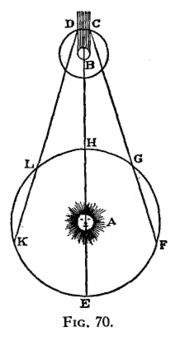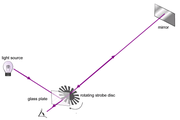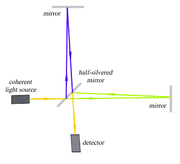Speed of light
2007 Schools Wikipedia Selection. Related subjects: General Physics
The speed of light in a vacuum is an important physical constant denoted by the letter c for constant or the Latin word celeritas meaning "swiftness". It is the speed of all electromagnetic radiation in a vacuum, not just visible light.
In metric units, c is exactly 299,792,458 metres per second (1,079,252,848.8 km/h). Note that this speed is a definition, not a measurement, since the fundamental SI unit of length, the metre, has been defined since October 21, 1983 in terms of the speed of light: one metre is the distance light travels in a vacuum in 1/299,792,458 of a second. Converted to imperial units, the speed of light is approximately 186,282.397 miles per second, or 670,616,629.384 miles per hour, or almost one foot per nanosecond.
Through any transparent or translucent material medium, like glass or air, it has a lower speed than in a vacuum; the ratio of c to this slower speed is called the refractive index of the medium. Changes of gravity, however, warp the space the light has to travel through, making it appear to curve around massive objects. This gives rise to the phenomenon of gravitational lensing, in which large assemblies of matter can refract light from far away sources, so as to produce multiple images and similar optical distortions.
Overview
One consequence of the laws of electromagnetism (such as Maxwell's equations) is that the speed c of electromagnetic radiation does not depend on the velocity of the object emitting the radiation; thus for instance the light emitted from a rapidly moving light source would travel at the same speed as the light coming from a stationary light source (although the colour, frequency, energy, and momentum of the light will be shifted, which is called the relativistic Doppler effect). If one combines this observation with the principle of relativity, one concludes that all observers will measure the speed of light in vacuum as being the same, regardless of the reference frame of the observer or the velocity of the object emitting the light. Because of this, one can view c as a fundamental physical constant. This fact can then be used as a basis for the theory of special relativity. It is worth noting that it is the constant speed c, rather than light itself, which is fundamental to special relativity; thus if light is somehow manipulated to travel at less than c, this will not directly affect the theory of special relativity.
Observers travelling at large velocities will find that distances and times are distorted ("dilated") in accordance with the Lorentz transforms; however, the transforms distort times and distances in such a way that the speed of light remains constant. A person travelling near the speed of light would also find that colours of lights ahead were shifted toward the violet end of the spectrum and of those behind were redshifted, so that the Lorentz transformations and classical explanations of shifting are in harmony.
If information could travel faster than c in one reference frame, causality would be violated: in some other reference frames, the information would be received before it had been sent, so the 'effect' could be observed before the 'cause' is. Due to special relativity's time dilation, the ratio between an external observer's perceived time and the time perceived by an observer moving closer and closer to the speed of light approaches zero. If something could move faster than light, this ratio would not be a real number. Such a violation of causality has never been observed.
To put it another way, information propagates to and from a point from regions defined by a light cone. The interval AB in the diagram to the right is ' time-like' (that is, there is a frame of reference in which event A and event B occur at the same location in space, separated only by their occurring at different times, and if A precedes B in that frame then A precedes B in all frames: there is no frame of reference in which event A and event B occur simultaneously). Thus, it is hypothetically possible for matter (or information) to travel from A to B, so there can be a causal relationship (with A the 'cause' and B the 'effect').
On the other hand, the interval AC in the diagram to the right is ' space-like' (that is, there is a frame of reference in which event A and event C occur simultaneously, separated only in space; (see simultaneity). However, there are also frames in which A precedes C (as shown) or in which C precedes A. Barring some way of travelling faster than light, it is not possible for any matter (or information) to travel from A to C or from C to A. Thus there is no causal connection between A and C.
According to the currently prevailing definition, adopted in 1983, the speed of light is exactly 299,792,458 metres per second (approximately 3 × 108 metres per second, or about thirty centimetres (one foot) per nanosecond). The value of c defines the permittivity of free space (ε0) in SI units as:
The permeability of free space (μ0) is not dependent on c and is defined in SI units as:
 .
.
These constants appear in Maxwell's equations, which describe electromagnetism, and are related by:
Astronomical distances are sometimes measured in light years (the distance that light would travel in one year, roughly 9.46 × 1012 kilometres or about 5.88 × 1012 miles) especially in popularised texts. Also because light travels at a large but finite speed, it takes time for light to cover large distances. Thus, when we see the light of very distant objects in the universe, we are actually seeing light emitted from them a long time ago: we see them literally as they were in the distant past.
Mnemonic
Since a nine-digit sequence is a bit hard to remember, there are several useful mnemonics for c in m/s, which use the letters on a telephone keypad:
- Constant Which We Remember Well Because It's Light's Velocity.
- A Way We Remember What Constant Is Light's Velocity.
For either of these, one can obtain the number 299,792,458 by translating the bolded letters to digits.
Communications and GPS
The speed of light is of relevance to communications. For example, given that the equatorial circumference of the Earth is 40100 km and c = 300000 km/s, the theoretical shortest amount of time for a piece of information to travel half the globe along the surface is 0.0668 s.
The actual transit time is longer, in part because the speed of light is slower by about 30% in an optical fibre and straight lines rarely occur in global communications situations, but also because delays are created when the signal passes through an electronic switch or signal regenerator. A typical time as of 2004 for an Australia or Japan to US computer-to-computer ping is 0.18 s. The speed of light additionally affects wireless communications design.
Another consequence of the finite speed of light is that communications with spacecraft are not instantaneous, especially as distances increase. This delay was significant for the communication of Houston ground control and Apollo 8 when it became the first spacecraft to orbit the Moon: For every question, Houston had to wait nearly 3 seconds for the answer to arrive, even when the astronauts replied immediately.
This effect forms the basis of the Global Positioning System (GPS), and similar navigation systems. One's position can be determined by means of the delays in light signals received from a number of satellites, each carrying a very accurate atomic clock, and very carefully synchronized. It is remarkable that, to work properly, this method requires to take into account (among many other effects) the relative motion of satellite and receiver, which was how (on an interplanetary scale) the finite speed of light was originally discovered (see the following).
Similarly, instantaneous remote control of interplanetary spacecraft is impossible because it takes time for the Earth-based controllers to receive information from the craft. It can take hours for controllers to become aware of a problem, respond with instructions, and have the spacecraft receive the instructions.
The speed of light can also be of concern on short distances. In supercomputers, the speed of light imposes a limit on how quickly data can be sent between processors. If a processor operates at 1 GHz, a signal can only travel a maximum of 300 mm in a single cycle. Processors must therefore be placed close to each other to minimise communication latencies. If clock frequencies continue to increase, the speed of light will eventually become a limiting factor for the internal design of single chips.
Physics
Interaction with transparent materials
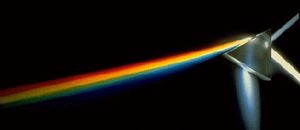
In passing through materials, light is slowed to less than c by the ratio called the refractive index of the material. The speed of light in air is only slightly less than c. Denser media, such as water and glass, can slow light much more, to fractions such as ¾ and 2/3 of c. This reduction in speed is also responsible for bending of light at an interface between two materials with different indices, a phenomenon known as refraction.
Since the speed of light in a material depends on the refractive index, and the refractive index depends on the frequency of the light, light at different frequencies travels at different speeds through the same material. This can cause distortion of electromagnetic waves that consist of multiple frequencies, called dispersion.
Note that the speed of light referred to is the observed or measured speed in some medium and not the true speed of light (as observed in vacuum). It may be noted, that once the light has emerged from the medium it changes back to its original speed and this is without gaining any energy. This can mean only one thing—that the light's speed itself was never altered in the first place.
It is sometimes claimed that light is slowed on its passage through a block of media by being absorbed and re-emitted by the atoms, only travelling at full speed through the vacuum between atoms. This explanation is incorrect and runs into problems if you try to use it to explain the details of refraction beyond the simple slowing of the signal.
Classically, considering electromagnetic radiation to be like a wave, the charges of each atom (primarily the electrons) interfere with the electric and magnetic fields of the radiation, slowing its progress.
The full quantum-mechanical explanation is essentially the same, but has to cope with the discrete particle nature (see Photons in matter): The E-field creates phonons in the media, and the photons mix with the phonons. The resulting mixture, called a polariton, travels with a speed slower than light.
"Faster-than-light" observations and experiments
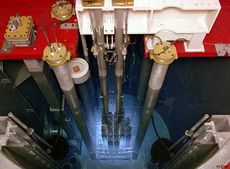
It has long been known theoretically that it is possible for the " phase velocity" of light to exceed c. One recent experiment made the group velocity of laser beams travel for extremely short distances through caesium atoms at 300 times c. However, it is not possible to use this technique to transfer information faster than c: the velocity of information transfer depends on the front velocity (the speed at which the first rise of a pulse above zero moves forward) and the product of the group velocity and the front velocity is equal to the square of the normal speed of light in the material.
Exceeding the group velocity of light in this manner is comparable to exceeding the speed of sound by arranging people distantly spaced in a line, and asking them all to shout "I'm here!", one after another with short intervals, each one timing it by looking at their own wristwatch so they don't have to wait until they hear the previous person shouting. Another example can be seen when watching ocean waves washing up on shore. With a narrow enough angle between the wave and the shoreline, the breakers travel along the wave's length much faster than the wave's movement inland.
The speed of light may also appear to be exceeded in some phenomena involving evanescent waves, such as tunnelling. Experiments indicate that the phase velocity of evanescent waves may exceed c; however, it would appear that neither the group velocity nor the front velocity exceed c, so, again, it is not possible for information to be transmitted faster than c.
In quantum mechanics, certain quantum effects may be transmitted at speeds greater than c (indeed, action at a distance has long been perceived by some as a problem with quantum mechanics: see EPR paradox, interpretations of quantum mechanics). For example, the quantum states of two particles can be entangled, so the state of one particle fixes the state of the other particle (say, one must have spin +½ and the other must have spin −½). Until the particles are observed, they exist in a superposition of two quantum states, (+½, −½) and (−½, +½). If the particles are separated and one of them is observed to determine its quantum state then the quantum state of the second particle is determined automatically. If, as in some interpretations of quantum mechanics, one presumes that the information about the quantum state is local to one particle, then one must conclude that second particle takes up its quantum state instantaneously, as soon as the first observation is carried out. However, it is impossible to control which quantum state the first particle will take on when it is observed, so no information can be transmitted in this manner. The laws of physics also appear to prevent information from being transferred through more clever ways and this has led to the formulation of rules such as the no-cloning theorem and the no-communication theorem.
So-called superluminal motion is also seen in certain astronomical objects, such as the jets of radio galaxies and quasars. However, these jets are not actually moving at speeds in excess of the speed of light: the apparent superluminal motion is a projection effect caused by objects moving near the speed of light and at a small angle to the line of sight.
Although it may sound paradoxical, it is possible for shock waves to be formed with electromagnetic radiation. As a charged particle travels through an insulating medium, it disrupts the local electromagnetic field in the medium. Electrons in the atoms of the medium will be displaced and polarised by the passing field of the charged particle, and photons are emitted as the electrons in the medium restore themselves to equilibrium after the disruption has passed. (In a conductor, the disruption can be restored without emitting a photon.) In normal circumstances, these photons destructively interfere with each other and no radiation is detected. However, if the disruption travels faster than the photons themselves travel, the photons constructively interfere and intensify the observed radiation. The result (analogous to a sonic boom) is known as Cherenkov radiation.
The ability to communicate or travel faster-than-light is a popular topic in science fiction. Particles that travel faster than light, dubbed tachyons, have been proposed by particle physicists but have yet to be observed.
Some physicists, notably João Magueijo and John Moffat, have proposed that in the past light travelled much faster than the current speed of light. This theory is called variable speed of light (VSL) and its supporters claim that it has the ability to explain many cosmological puzzles better than its rival, the inflation model of the universe. However, it has yet to gain wide acceptance.
In 2002, physicists Alain Haché and Louis Poirier made history by sending pulses at a group velocity of three times light speed over a long distance for the first time, transmitted through a 120-metre cable made from a coaxial photonic crystal.
"Slow Light" Experiments
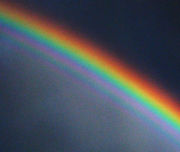
Any light travelling through a medium other than a vacuum travels below c as a result of the time lag between the polarization response of the medium and the incident light. However, certain materials have an exceptionally high group index and a correspondingly low group velocity. In 1999, a team of scientists led by Lene Hau were able to slow the speed of a light pulse to about 17 metres per second, and in 2001, they were able to momentarily stop a beam.
In 2003, Mikhail Lukin, with scientists at Harvard University and the Lebedev Institute in Moscow, succeeded in completely halting light by directing it into a mass of hot rubidium gas, the atoms of which, in Lukin's words, behaved "like tiny mirrors", due to an interference pattern in two "control" beams.
History
Until relatively recent times, the speed of light was largely a matter of conjecture. Empedocles maintained that light was something in motion, and therefore there had to be some time elapsed in travelling. Aristotle said that, on the contrary, "light is due to the presence of something, but it is not a movement". Furthermore, if light had a finite speed, it would have to be very great; Aristotle asserted "the strain upon our powers of belief is too great" to believe this.
One of the ancient theories of vision is that light is emitted from the eye, instead of being reflected into the eye from another source. On this theory, Heron of Alexandria advanced the argument that the speed of light must be infinite, since distant objects such as stars appear immediately when one opens one's eyes.
Medieval and early modern theories
The Islamic philosophers Avicenna and Alhazen believed that light has a finite speed, although most philosophers agreed with Aristotle on this point.
The philosophers of ancient India also held the speed of light to be finite. The 14th century scholar Sayana wrote in a comment on verse 1.50 of the Rig Veda:
- "Thus it is remembered: [O Sun] you who traverse 2202 yojanas in half a nimesa."
Sayana's statement comes very close to the actual speed of light, and has been called the most astonishing "blind hit" in the history of science.
Johannes Kepler believed that the speed of light is infinite since empty space presents no obstacle to it. Francis Bacon argued that the speed of light is not necessarily infinite, since something can travel too fast to be perceived. René Descartes argued that if the speed of light were finite, the Sun, Earth, and Moon would be noticeably out of alignment during a lunar eclipse. Since such misalignment had not been observed, Descartes concluded the speed of light is infinite. In fact, Descartes was convinced that if the speed of light were finite, his whole system of philosophy would be demolished.
Measurement of the speed of light
Isaac Beeckman proposed an experiment ( 1629) in which a person would observe the flash of a cannon reflecting off a mirror about one mile away. Galileo proposed an experiment (1638), with an apparent claim to having performed it some years earlier, to measure the speed of light by observing the delay between uncovering a lantern and its perception some distance away. This experiment was carried out by the Accademia del Cimento of Florence in 1667, with the lanterns separated by about one mile. No delay was observed. Robert Hooke explained the negative results as Galileo had: by pointing out that such observations did not establish the infinite speed of light, but only that the speed must be very great. Descartes criticised this experiment as superfluous, in that the observation of eclipses, which had more power to detect a finite speed, gave a negative result.
The first quantitative estimate of the speed of light was made in 1676 by Ole Rømer, who was studying the motions of Jupiter's satellite Io with a telescope. It is possible to time the orbital revolution of Io because it enters and exits Jupiter's shadow at regular intervals (at C or D). Rømer observed that Io revolved around Jupiter once every 42.5 hours when Earth was closest to Jupiter. He also observed that, as Earth and Jupiter moved apart (as from L to K), Io's exit from the shadow would begin progressively later than predicted. It was clear that these exit "signals" took longer to reach Earth, as Earth and Jupiter moved further apart. As a result of the extra time it took for light to cross the extra distance between the planets, which had accumulated in the interval between one signal and the next. The opposite is the case when they are approaching (as from F (not shown but opposite of K) to G). Quite as in the familiar Doppler effect. On the basis of his observations, Rømer estimated that it would take light 22 minutes to cross the diameter of the orbit of the Earth (that is, twice the astronomical unit); the modern estimate is closer to 16 minutes and 40 seconds.
Around the same time, the astronomical unit was estimated to be about 140 million kilometres. The astronomical unit and Rømer's time estimate were combined by Christiaan Huygens, who estimated the speed of light to be 1000 Earth diameters per minute. This is about 220,000 kilometres per second (136,000 miles per second), well below the currently accepted value, but still very much faster than any physical phenomenon then known.
Isaac Newton also accepted the finite speed. In his book " Opticks" he, in fact, reports the more accurate value of 16.6 Earth diameters per second, which it seems he inferred for himself (whether from Rømer's data, or otherwise, is not known). The same effect was subsequently observed by Rømer for a "spot" rotating with the surface of Jupiter. And later observations also showed the effect with the three other Galilean moons, where it was more difficult to observe, thus laying to rest some further objections that had been raised.
Even if, by these observations, the finite speed of light may not have been established to everyone's satisfaction (notably Jean-Dominique Cassini's), after the observations of James Bradley ( 1728), the hypothesis of infinite speed was considered discredited. Bradley deduced that starlight falling on the Earth should appear to come from a slight angle, which could be calculated by comparing the speed of the Earth in its orbit to the speed of light. This "aberration of light", as it is called, was observed to be about 1/200 of a degree. Bradley calculated the speed of light as about 298,000 kilometres per second (185,000 miles per second). This is only slightly less than the currently accepted value. The aberration effect has been studied extensively over the succeeding centuries, notably by Friedrich Georg Wilhelm Struve and Magnus Nyren.
The first successful measurement of the speed of light using an earthbound apparatus was carried out by Hippolyte Fizeau in 1849. Fizeau's experiment was conceptually similar to those proposed by Beeckman and Galileo. A beam of light was directed at a mirror several thousand metres away. On the way from the source to the mirror, the beam passed through a rotating cog wheel. At a certain rate of rotation, the beam could pass through one gap on the way out and another on the way back. But at slightly higher or lower rates, the beam would strike a tooth and not pass through the wheel. Knowing the distance to the mirror, the number of teeth on the wheel, and the rate of rotation, the speed of light could be calculated. Fizeau reported the speed of light as 313,000 kilometres per second. Fizeau's method was later refined by Marie Alfred Cornu ( 1872) and Joseph Perrotin ( 1900).
Leon Foucault improved on Fizeau's method by replacing the cogwheel with a rotating mirror. Foucault's estimate, published in 1862, was 298,000 kilometres per second. Foucault's method was also used by Simon Newcomb and Albert A. Michelson. Michelson began his lengthy career by replicating and improving on Foucault's method.
In 1926, Michelson used a rotating prism to measure the time it took light to make a round trip from Mount Wilson to Mount San Antonio in California. The precise measurements yielded a speed of 186,285 miles per second (299,796 kilometres per second).
Relativity
From the work of James Clerk Maxwell, it was known that the speed of electromagnetic radiation was a constant defined by the electromagnetic properties of the vacuum ( permittivity and permeability).
In 1887, the physicists Albert Michelson and Edward Morley performed the influential Michelson-Morley experiment to measure the speed of light relative to the motion of the earth, the goal being to measure the velocity of the Earth through the "luminiferous aether", the medium that was then thought to be necessary for the transmission of light. As shown in the diagram of a Michelson interferometer, a half-silvered mirror was used to split a beam of monochromatic light into two beams travelling at right angles to one another. After leaving the splitter, each beam was reflected back and forth between mirrors several times (the same number for each beam to give a long but equal path length; the actual Michelson-Morley experiment used more mirrors than shown) then recombined to produce a pattern of constructive and destructive interference. Any slight change in speed of light along each arm of the interferometer (because the apparatus was moving with the Earth through the proposed "aether") would change the amount of time that the beam spent in transit, which would then be observed as a change in the pattern of interference. In the event, the experiment gave a null result.
Ernst Mach was among the first physicists to suggest that the experiment actually amounted to a disproof of the aether theory. Developments in theoretical physics had already begun to provide an alternate theory, Fitzgerald-Lorentz contraction, which explained the null result of the experiment.
It is uncertain whether Albert Einstein knew the results of the Michelson-Morley experiment, but the null result of the experiment greatly assisted the acceptance of his theory of relativity. Einstein's theory did not require an aether and was entirely consistent with the null result of the experiment: the aether did not exist and the speed of light was the same in each direction. The constant speed of light is one of the fundamental Postulates (together with causality and the equivalence of inertial frames) of special relativity.




